Composition of large asteroids collided with the Earth
- Bensheim, Germany (schmdtgerhard@aol.com)
1. Introduction
The composition of a chondrite reflects the combination of chemical processes that produced the set of solid components at that nebular location and mechanical processes that led to the incorporation of variable amounts of these components into the chondrite [1]. Large difference in condensation temperature of about 200 K between Rh and Ir, have led to some variation in platinum group element (PGE) composition in chondrites during solar nebula condensation processes. Carbonaceous and non-carbonaceous (ordinary and enstatite) chondrites exhibit successively higher degrees of reduction combined with successively lower contents of refractory elements. These features, as discussed as early as the 1970s, are most likely related to formation at increasingly smaller radial distances from the Sun in hotter parts of the solar nebula. However, since analytical mass spectrometry techniques, with few exceptions, do not measure the monoisotopic element Rh in chondrites, there are significantly fewer data on Rh than Ir and Ru.
The fundamental dichotomy between carbonaceous and noncarbonaceous chondrite groups is shown in a Ru/Rh vs. Ir/Rh diagram (Figure 1). Ruthenium/Rh and Ir/Rh ratios are the best to distinguish chondrite groups [1-4].
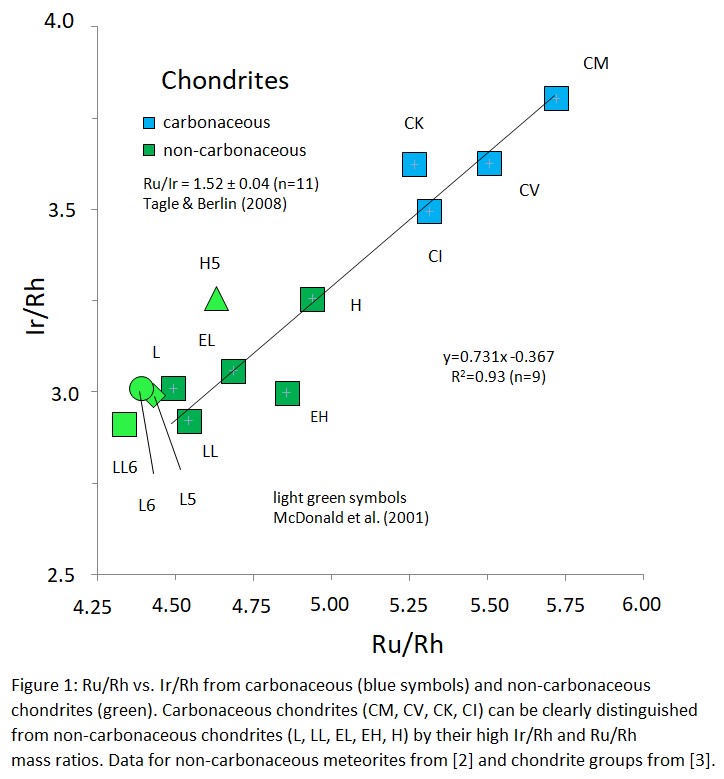
2. How to distinguish iron meteorites and chondrites?
Nonchondritic PGE ratios from some iron meteorite groups are most likely the result of fractional crystallization of a metallic liquid during core formation. Compositional differences in the chemistry of PGE from chondrites and iron meteorites (Figure 2) allow the rough identification of projectile types based on PGE traces in melt samples or fallback sediments from impact craters.
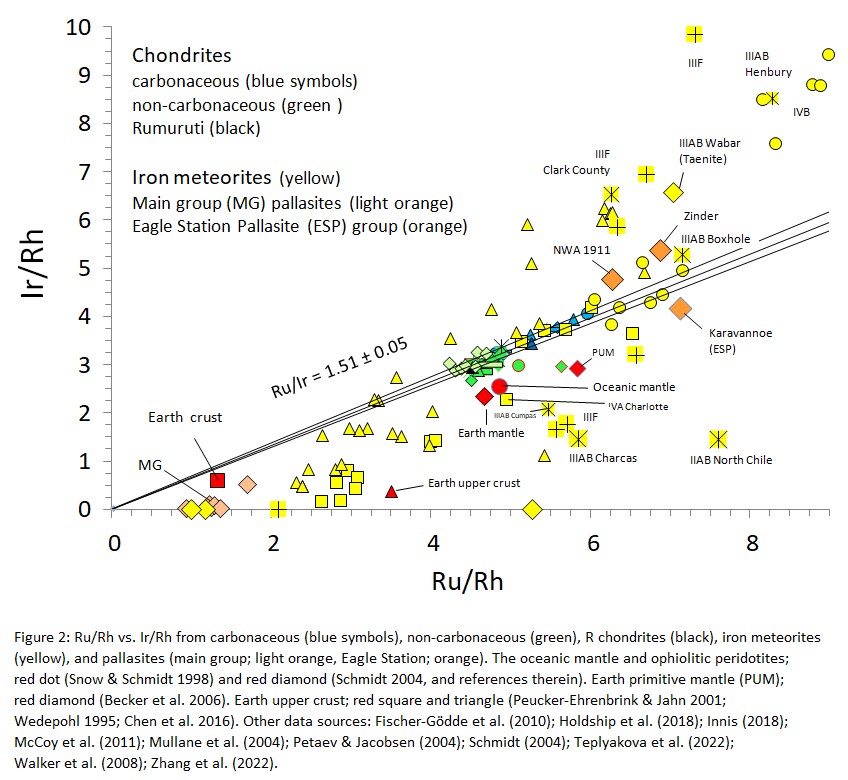
An indicator to distinguish chondrites from iron meteorites is there constant Ru/Ir ratio of 1.51 ± 0.05. However, some IVA (La Grange, Yanhuitlan, Maria Elena, Jamestown), IVB (Ternera, Skookum, Warburton Range), and IC (Arispe) irons also have Ru/Ir ratios of about 1.5 and thus cannot be distinguished from chondrites by their Ru/Rh and Ir/Rh ratios (Figure 3).
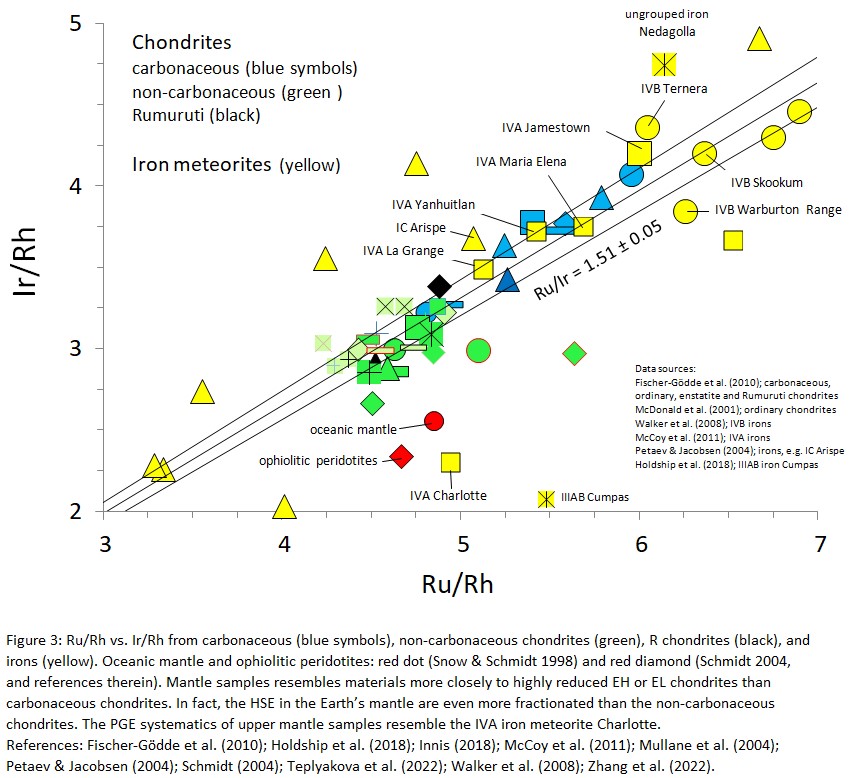
3. Identified iron meteoritic projectiles from large terrestrial impact craters
In melt samples from the Sääksjärvi impact crater in Finland CI-normalized abundances increase from the refractory to the more volatile siderophile elements (Ir < Ni). The trend is qualitatively similar to magmatic iron meteorites and corresponds to about 0.4% of a nominal magmatic iron meteorite component (e.g. IIIAB Tamarugal, see web version at RG) [5].
Non-chondritic PGE ratios in fallback sediments from the Chicxulub crater (Mexico) imply a meteoritic contribution equivalent to about 0.1% Mundrabilla-like iron [6].
Iron meteoritc normalized PGE, Ni and Au pattern of Clearwater East melt samples would imply a meteoritic contribution equivalent to about 0.6 to 1.2% IVA Gibeon-like iron [7], or an unknown chondrite (Palme 2019, personal communication).
Except the Morokweng impact structure in South Africa all large craters with diameters >1 km are formed by iron projectiles. Studies of PGE ratios in Morokweng samples suggested an ordinary chondrite as projectile (Figure 5)[2,8]. However, based on PGE, Au and Ni concentrations in Morokweng melt samples would imply a meteoritic contribution equivalent to about 0.4 to 0.8 % Gibeon-like iron (Figure 4). If no asteroid clast had been discovered, incorrect conclusions would be drawn based on PGE ratios alone.
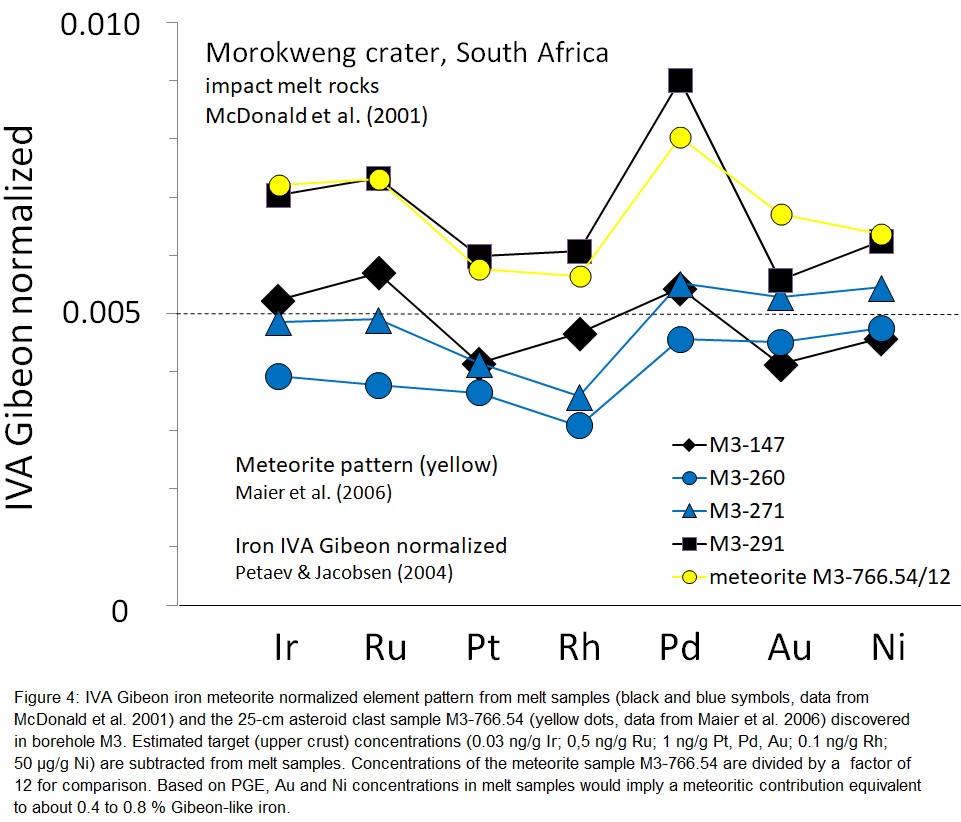
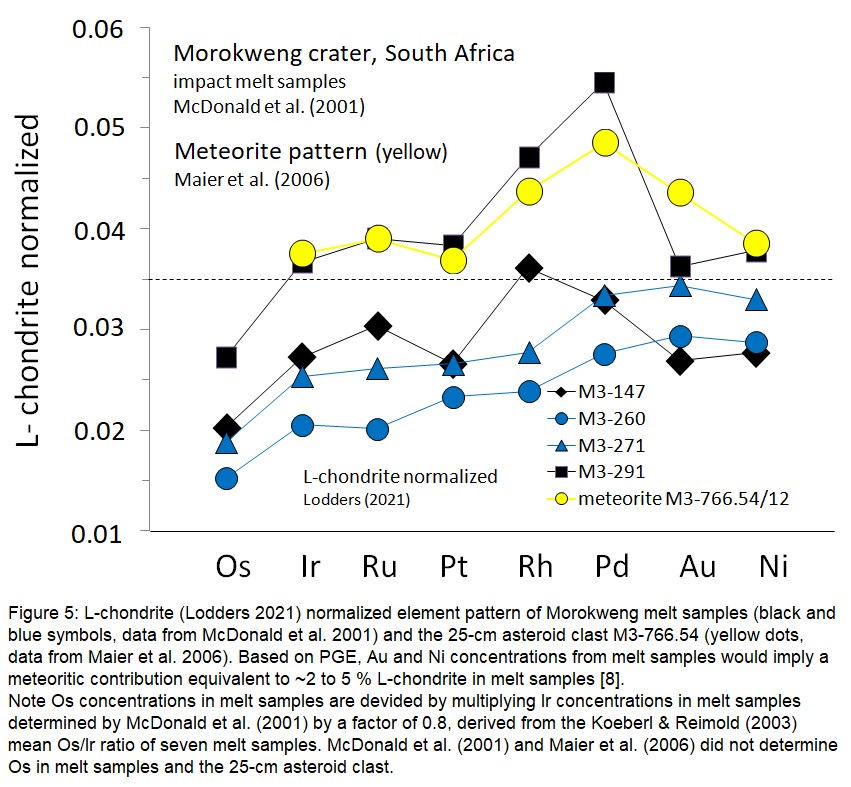
4. Iron meteorite PGE abundance pattern from the Earth mantle and crust
The elemental ratios or PGE patterns of oceanic peridotites and ophiolitic peridotites [9,10] agree with the IVA iron meteorite Charlotte (Figure 6). This agreement revives the discussion of whether the precious metal concentrations in the oceanic mantle can be explained by entrainment of the outer core by deep-seated mantle plumes or impact(s) after core formation. The PGE pattern of the Earth’s upper crust has shown to be similar to that of the IIIAB iron Grant and the pallasite Brenham.
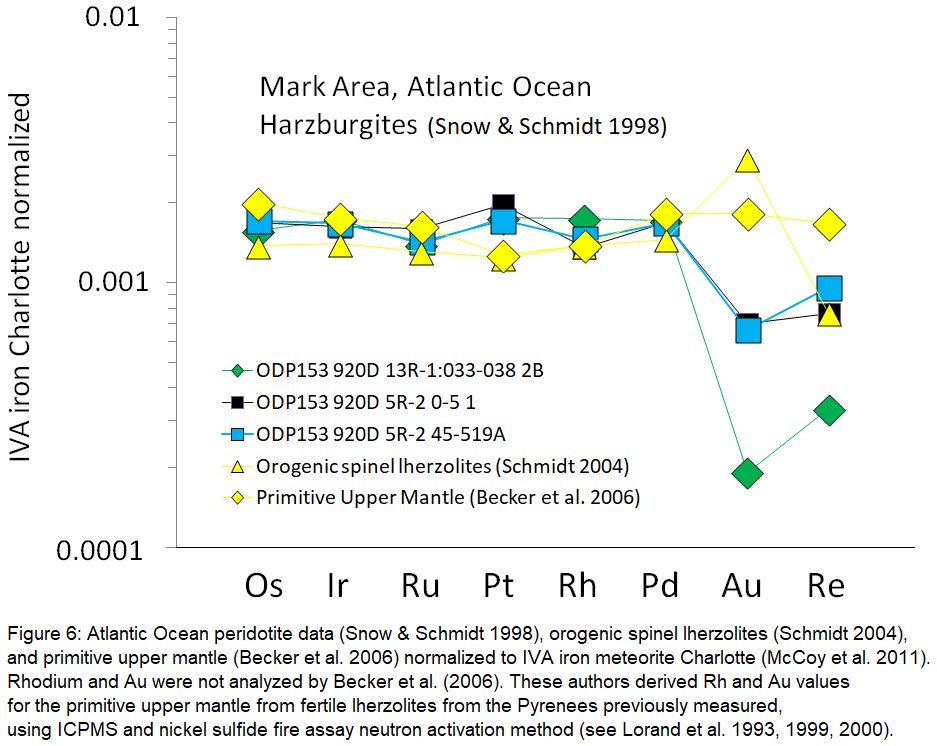
5. Future studies
Progress in more precise identification of impactors can probably only be made by combining meteorite science and astrophysics. Comparing the Ru isotopic composition of impact melts with that of meteorites could therefore provide important clues to the origin of projectiles and with some limitations, could be used as a powerful analytical tool [11] alongside diagnostic Ru/Rh and Ir/Rh mass ratios to identify impactor signatures.
References
[1] Wasson J. T. (1985) Meteorites - Their Record of Early Solar-System History. Freeman & Company, New York, 267pp.
[2] McDonald I., Andreoli M. A. G., Hart R. J. & Tredoux M. (2001) Platinum-group elements in the Morokweng impact structure, South Africa: Evidence for the impact of a large ordinary chondrite projectile at the Jurassic-Cretaceous boundary. Geochimica et Cosmochimica Acta 65, 299-309.
[3] Tagle R. & Berlin J. (2008) A database of chondrite analysis including platinum group elements, Ni, Co, Au, and Cr: implications for the identification of chondritic projectiles. Meteoritics & Planetary Science 43, 541 - 559.
[4] Fischer-Gödde M., Becker H. & Wombacher F. (2010) Rhodium, gold and other highly siderophile element abundances in chondritic meteorites. Geochimica et Cosmochimica Acta 74, 356-379.
[5] Schmidt G., Palme H. & Kratz K.-L. (1997) Highly siderophile elements (Re, Os, Ir, Ru, Rh, Pd, Au) in impact melts from three European craters (Sääksjärvi, Mien and Dellen): clues to the nature of the impacting bodies. Geochimica et Cosmochimica Acta 61, 2977-2987.
[6] Schmidt G. (2022) Identification of iron meteorites as projectiles from large impact craters. 53rd Lunar and Planetary Science Conference, #1272.
[7] Schmidt G. (2019) Re-investigation of projectile types from terrestrial impact craters – Hiawatha (Greenland), Popigai (Siberia), Clearwater East, Brent, Wanapitei (Canada), Gardnos (Norway), Rochechouart (France), Ries (Germany), EPSC-DPS Joint Meeting 2019, EPSC-DPS2019-4.
[8] Koeberl C. & Reimold W. U. (2003) Geochemistry and petrography of impact breccias and target rocks from the 145 Ma Morokweng impact structure, South Africa. Geochimica et Cosmochimica Acta 67, 1837 - 1862.
[9] Snow J.E. & Schmidt G. (1998) Constraints on the Earth accretion deduced from noble metals in the oceanic mantle. Nature 391, 166-169.
[10] Schmidt G. (2004) Are high-temperature fractionations in the solar nebula preserved in highly siderophile element systematics of the Earth’s mantle? Meteoritics & Planetary Science 39, 1995 - 2007.
[11] Fischer-Gödde M., Burkhardt C., Kruijer T. S. & Kleine T. (2015) Ru isotope heterogeneity in the solar protoplanetary disk. Geochimica et Cosmochimica Acta 168, 151-171.
How to cite: Schmidt, G.: Composition of large asteroids collided with the Earth, Europlanet Science Congress 2022, Granada, Spain, 18–23 Sep 2022, EPSC2022-106, https://doi.org/10.5194/epsc2022-106, 2022.

